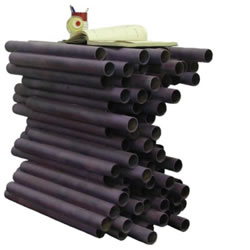A scuola di riuso / Reuse at school
Cosa sono e come sono nati i Laboratori Ricicloni? Come viene accolto un “architetto dei rifiuti” in ambito didattico, c’è diffidenza?
What is “Laboratori Ricicloni”, and how did you conceive it? How is a “waste architect” received in schools, is there any suspicion?
SB - Un giorno mi sono chiesta perché non cominciare a "contagiare" i più piccoli, ma anche i più grandi, e così, da parecchi anni ormai, girovago tra scuole elementari, centri culturali, piazze e mostre, con sacchi pieni di "rifiuti" pronti per essere trasformati.
I Laboratori Ricicloni sono veri e propri seminari, a misura di bambino, pensati per diffondere la cultura del riuso attraverso il gioco e il divertimento. Sono nati per rispondere, da un lato, alla voglia di trasmettere questa mia passione per la trasformazione di ciò che si butta e, dall’altro, dall’esigenza degli insegnanti di spiegare in modo pratico ai bambini che cosa significa “riciclare”. Forse, presentandomi come architetto, riesco a dare un po’ più di fiducia nel momento in cui i finanziamenti per questo tipo di progetti vengono richiesti ai vertici della scuola - anche se negli ultimi anni, data la situazione in cui si trovano gli istituti didattici, sta diventando molto difficile riuscire a lavorare.
Con i piccoli allievi, invece, l’importante è catturare la loro attenzione e il loro interesse: l’obiettivo per me è innescare la scintilla che li illumina quando riescono a guardare “oltre” i materiali che si trovano davanti ai loro occhi, a creare qualcosa con le loro mani, partendo da un oggetto “rifiutato”.
SB - One day I wondered why not start “infecting” the young children, and the older people, too, so, for several years now, I’ve been moving around among elementary schools, cultural centers, squares and exhibitions, with bags full of “waste” ready to be transformed.
Laboratori Ricicloni (something like “Big-Recycler Laboratories”) are real child-friendly workshops, intended to spread the culture of recycling through fun and game. They have been created to give an answer, on the one hand, to my wish to transmit this passion for the transformation of what’s thrown away, and, on the other hand, to fulfill teachers’ need to explain to children what does it mean “recycling” in practice.
Maybe, introducing myself as an architect, I prove to be a little bit more reliable, when school management is asked to give funds for this kind of projects - in recent years, however, due to the condition of educational facilities, it’s getting very hard to get the job done.
Whereas, in regard to young pupils, the main thing is catching their attention, and getting them involved: my purpose is to light up the spark that illuminates them when they succeed in seeing what is “beyond” the materials they’re staring at, when they create something with their hands, starting from a “discarded” object.











